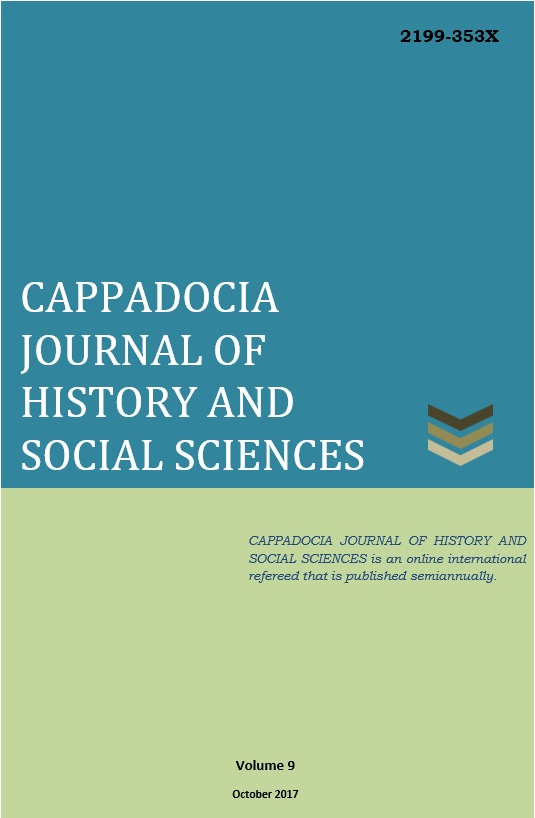Author :
Abstract
Šimat-Su’en, Asur Ticaret Kolonbileri Çağı olarak adlandırılan dönemde Anadolu’da ticari faaliyetlerde bulunan ve tanınmış bir tüccar olarak bilinen U?ur-ša-İštar’ın kız kardeşidir. Asur’da ikamet eden Šimat-Su’en, Anadolu’daki ticari faaliyetlere doğrudan müdahil olduğu gibi firmanın Asur’daki işlerini de yakından takip etmiş ve ağabeyi U?ur-ša-İštar’ın ticari etkinliklerinde önemli rol oynamıştır. Bu durum ağabeyi ile olan yazışmalarına da yansımış bulunmaktadır. Fakat bu yazışmalar, daha çok Asur’da kendisini yalnız hisseden bir bayanın duygularını göstermesiyle ön plana çıkmaktadır.
Keywords
Abstract
Sumerian has eleven grammatical cases commonly accepted. Case markers in Sumerian may add to only nouns as postfixes. Morover, several of those nominal case markers can influence both the noun and verb. Some, on the other hand, can attach to only inanimate nouns while some others are attachable to only those of animate. There are case markers that can be added to all kind of nouns as well. At all events, that Sumerian has a historical depth and progress should not be ignored. One can observe that some rules of the language present changes when texts of various periods are treated. Such changes become apparent especially towards the end of the Sumerian age. Following the dominance of the semitic peoples over the Sumerians, a gradual semiticisized feature in Sumerian can be ascertained. The grammar of Sumerian has not been written dealing with the details of temporal shifts or differences yet. Accordingly, the nominal cases and their functions in Sumerian will be treated in this study as generally acknowledged.
Keywords
- Aydın, N. (2000). Sumerce Dilbilgisi. Antalya: Tekin Grafik Ofset Matbaacılık.
- Clauson, S. G. (1972). An Etymological Dictionary of Pre-Thirteenth-Century Turkish . London: Oxford University Press.
- Curnow, A. J. (2004). Language Descriptions. C. E. Alan Davies (Dü.) içinde, The Handbook of Applied Linguistics (s. 25-54). Blackwell Publishing Ltd.
- Edzard, D. O. (2003). Sumerian Grammar. Leiden-Boston: Brill.
- Emine Gürsoy-Naskali, M. D. (1999). N.A. Baskakov ile T.M. Toşçakova’nın Oyrotsko-Russkıy Slovar’ından Genişletilmiş Altayca-Türkçe Sözlük. içinde Ankara: TDK.
- ePSD (2017). Electronic Text Corpus of Sumerian: http://psd.museum.upenn.edu adresinden alındı
- Eratalay, S. (2008). Sumerce ve Türkçede Ad Durum Ekleri. Dil Karşısında Dil (s. 7- 25). içinde Van: Van Yüzüncü Yıl Üniversitesi Yayınları.
- Eratalay, S. (2014). Sümerce ile Türkçe’nin Biçimbilimsel ve Sözdizimsel Açıdan İncelenmesi . Doktora Tezi. Van: T.C. Yüzüncü Yıl Üniversitesi, Sosyal Bilimler Enstitüsü, Türk Dili ve Edebiyatı Anabilim Dalı, Türk Dili Bilim Dalı.
- Erdal, M. (2004). A Grammar of Old Turkic (3 b.). Leiden-Boston: Brill.
- Ergin, M. (2009). Türk Dil Bilgisi. İstanbul: Bayrak.
- ETCSL. (2017). The Electronic Text Corpus of Sumerian Literature: http://etcsl.orinst.ox.ac.uk/ adresinden alındı
- Foxvog, D. A. (1975). The Sumerian Ergative Construction. Orientalia, 44(3), s. 395- 425.
- Foxvog, D. A. (2011). Introduction to Sumerian Grammar. Berkeley: University of California.
- Gökçek, L. G. (2015). Asurlular. Ankara: Bilgin Kültür Sanat Yayınları.
- Haber, E. (2009). The Stylistic Role of the Anticipatory Genitive Construction in Sumerian Literature. Revue d'assyriologie et d'archéologie orientale, 1(103), 37-47.
- Hameeuw, H. (2015). Mesopotamian Clay Cones in the ancient Near East Collections of the Royal Museums of Art and History. Bulletin des Musées royaux d'Art et d'Histoire, 84(2013), s. 5-48.
- Hayes, J. L. (1990). A Manuel of Sumerian Grammar and Texts. Malibu: Undena Publications.
- Jagersma, A. H. (2010). A Descriptive Grammar of Sumerian. Faculty of the Humanities, Leiden University.
- JSTOR (2017) Scholarly Journal Archive, www.jstor.org.
- Karahashi, F. (2004). Some Observations on Sumerian Compound Verbs. Orient (39), 96-110.
- Korkmaz, Z. (2009). Türkiye Türkçesi Grameri-Şekil Bilgisi (3. Baskı b.). Ankara: Türk Dil Kurumu.
- Menges, K. H. (1995). The Turkic Languages and Peoples: An Introduction to Turkic Studies (2nd rev. edition b.). Wiesbaden: Harrassowitz Verlag.
- Narçın, A. (2007). A'dan Z'ye Sümer. İstanbul: Ozan.
- ORACC (2017). Open Richly Annotated Cuneiform Corpus, http://oracc.museum.upenn.edu
- Rubio, G. (2007). Sumerian Morphology. A. S. Kaye (Dü.) içinde, Morphologies of Asia and Africa (Cilt 1, s. 1330-1350). Winona Lake, Indiana: Eisenbrauns.
- Thomson, M.-L. (1984). The Sumerian Language: An Introduction to Its History and Grammatical Structure (Cilt 10). Copenhagen: Akademik Forlag.
- Timurtaş, F. K. (1976). Eski Anadolu Türkçesi Grameri. Türkiyat Mecmuası, 18, s. 331-368.
- Trask, R. L. (1992). A Dictionary of Grammatical Terms in Linguistics. New York: Routledge.
- Volk, K. (1999). A Sumerian Reader (2 b.). Roma: Editrice Pontificio Istituto Biblico.
- Woods, C. (2008). The Grammar of Perspective. Leiden-Boston: Brill.
- Zólyomi, G. (2010). The Case of the Sumerian Cases. L. K. vd. (Dü.), Language in the Ancient Near East (2 parts) (Babel und Bibel, 4A-B) Proceedings of the 53e Rencontre Assyriologique Internationale içinde (s. 577–590). Winona Lake: Eisenbrauns.
- Zólyomi, G. (2014). Copular Clauses and Focus Marking in Sumerian. Berlin: De Gruyter Open.
- Zólyomi, G. (2017). An Introduction to the Grammar of Sumerian. Budapest: Eötves University Press.
